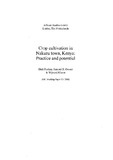| dc.contributor.author | Foeken, D.W.J | |
| dc.contributor.author | Owuor, S.O | |
| dc.contributor.author | Klaver, W | |
| dc.date.accessioned | 2013-06-24T08:38:43Z | |
| dc.date.available | 2013-06-24T08:38:43Z | |
| dc.date.issued | 2002 | |
| dc.identifier.citation | Foeken,D.W.J.;Owuor,S.O. and Klaver,W (2002). Crop cultivation in Nakuru town, Kenya: Practice and potential | en |
| dc.identifier.uri | https://openaccess.leidenuniv.nl/handle/1887/386 | |
| dc.identifier.uri | http://hdl.handle.net/11295/38785 | |
| dc.description.abstract | In Nakuru town (northwest of Nairobi, Kenya), two out of five households were living in conditions of absolute poverty in 1997. Farming in town is one of the ways people employ to cope with this problem. Based on a survey held in 1999 among almost 600 households, it is estimated that about 30 percent of the Nakuru population is engaged in crop cultivation in town. Following a general discussion of crop cultivation in sub-Saharan Africa and more particularly Kenya, this paper answers the following questions: what crops are cultivated in Nakuru town and on what types of plots? Who cultivates? What types of inputs are used and on which plots? Do different people use different inputs? What yields are being realized? Do harvests vary with types of plots, with household characteristics and with types of inputs? Why do people cultivate crops? What problems do they face? Who benefits and in what ways? How can crop cultivation in town be improved? What role does the municipality play? | en |
| dc.language.iso | en | en |
| dc.title | Crop cultivation in Nakuru town, Kenya: Practice and potential | en |
| dc.type | Book | en |

